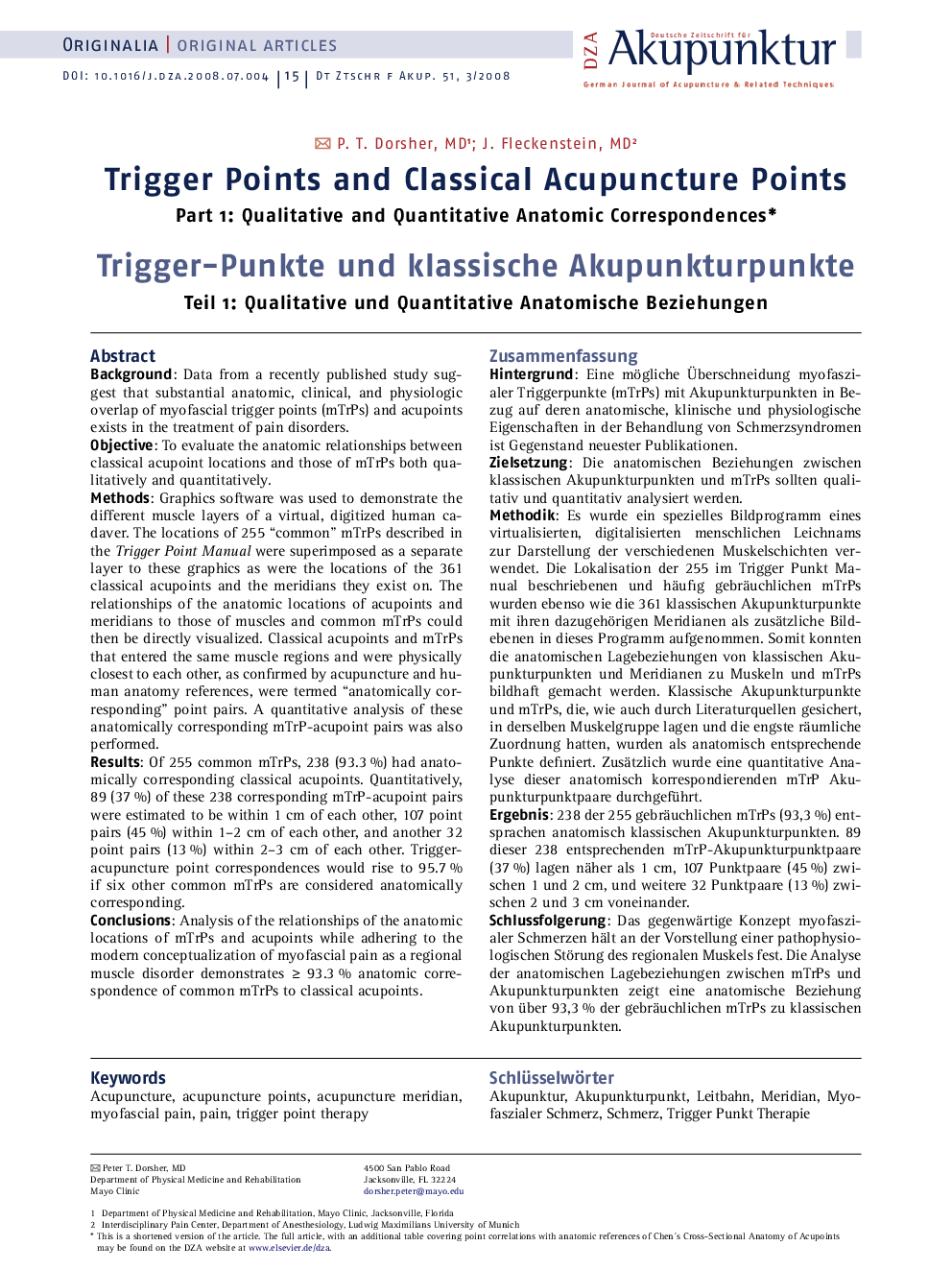| کد مقاله | کد نشریه | سال انتشار | مقاله انگلیسی | نسخه تمام متن |
|---|---|---|---|---|
| 2615367 | 1135086 | 2008 | 10 صفحه PDF | دانلود رایگان |

BackgroundData from a recently published study suggest that substantial anatomic, clinical, and physiologic overlap of myofascial trigger points (mTrPs) and acupoints exists in the treatment of pain disorders.ObjectiveTo evaluate the anatomic relationships between classical acupoint locations and those of mTrPs both qualitatively and quantitatively.MethodsGraphics software was used to demonstrate the different muscle layers of a virtual, digitized human cadaver. The locations of 255 “common” mTrPs described in the Trigger Point Manual were superimposed as a separate layer to these graphics as were the locations of the 361 classical acupoints and the meridians they exist on. The relationships of the anatomic locations of acupoints and meridians to those of muscles and common mTrPs could then be directly visualized. Classical acupoints and mTrPs that entered the same muscle regions and were physically closest to each other, as confirmed by acupuncture and human anatomy references, were termed “anatomically corresponding” point pairs. A quantitative analysis of these anatomically corresponding mTrP-acupoint pairs was also performed.ResultsOf 255 common mTrPs, 238 (93.3 %) had anatomically corresponding classical acupoints. Quantitatively, 89 (37 %) of these 238 corresponding mTrP-acupoint pairs were estimated to be within 1 cm of each other, 107 point pairs (45 %) within 1–2 cm of each other, and another 32 point pairs (13 %) within 2–3 cm of each other. Trigger-acupuncture point correspondences would rise to 95.7 % if six other common mTrPs are considered anatomically corresponding.ConclusionsAnalysis of the relationships of the anatomic locations of mTrPs and acupoints while adhering to the modern conceptualization of myofascial pain as a regional muscle disorder demonstrates ≥ 93.3 % anatomic correspondence of common mTrPs to classical acupoints.
ZusammenfassungHintergrundEine mögliche Überschneidung myofaszialer Triggerpunkte (mTrPs) mit Akupunkturpunkten in Bezug auf deren anatomische, klinische und physiologische Eigenschaften in der Behandlung von Schmerzsyndromen ist Gegenstand neuester Publikationen.ZielsetzungDie anatomischen Beziehungen zwischen klassischen Akupunkturpunkten und mTrPs sollten qualitativ und quantitativ analysiert werden.MethodikEs wurde ein spezielles Bildprogramm eines virtualisierten, digitalisierten menschlichen Leichnams zur Darstellung der verschiedenen Muskelschichten verwendet. Die Lokalisation der 255 im Trigger Punkt Manual beschriebenen und häufig gebräuchlichen mTrPs wurden ebenso wie die 361 klassischen Akupunkturpunkte mit ihren dazugehörigen Meridianen als zusätzliche Bildebenen in dieses Programm aufgenommen. Somit konnten die anatomischen Lagebeziehungen von klassischen Akupunkturpunkten und Meridianen zu Muskeln und mTrPs bildhaft gemacht werden. Klassische Akupunkturpunkte und mTrPs, die, wie auch durch Literaturquellen gesichert, in derselben Muskelgruppe lagen und die engste räumliche Zuordnung hatten, wurden als anatomisch entsprechende Punkte definiert. Zusätzlich wurde eine quantitative Analyse dieser anatomisch korrespondierenden mTrP Akupunkturpunktpaare durchgeführt.Ergebnis238 der 255 gebräuchlichen mTrPs (93,3 %) entsprachen anatomisch klassischen Akupunkturpunkten. 89 dieser 238 entsprechenden mTrP-Akupunkturpunktpaare (37 %) lagen näher als 1 cm, 107 Punktpaare (45 %) zwischen 1 und 2 cm, und weitere 32 Punktpaare (13 %) zwischen 2 und 3 cm voneinander.SchlussfolgerungDas gegenwärtige Konzept myofaszialer Schmerzen hält an der Vorstellung einer pathophysiologischen Störung des regionalen Muskels fest. Die Analyse der anatomischen Lagebeziehungen zwischen mTrPs und Akupunkturpunkten zeigt eine anatomische Beziehung von über 93,3 % der gebräuchlichen mTrPs zu klassischen Akupunkturpunkten.
Journal: Deutsche Zeitschrift für Akupunktur - Volume 51, Issue 3, 2008, Pages 15–24